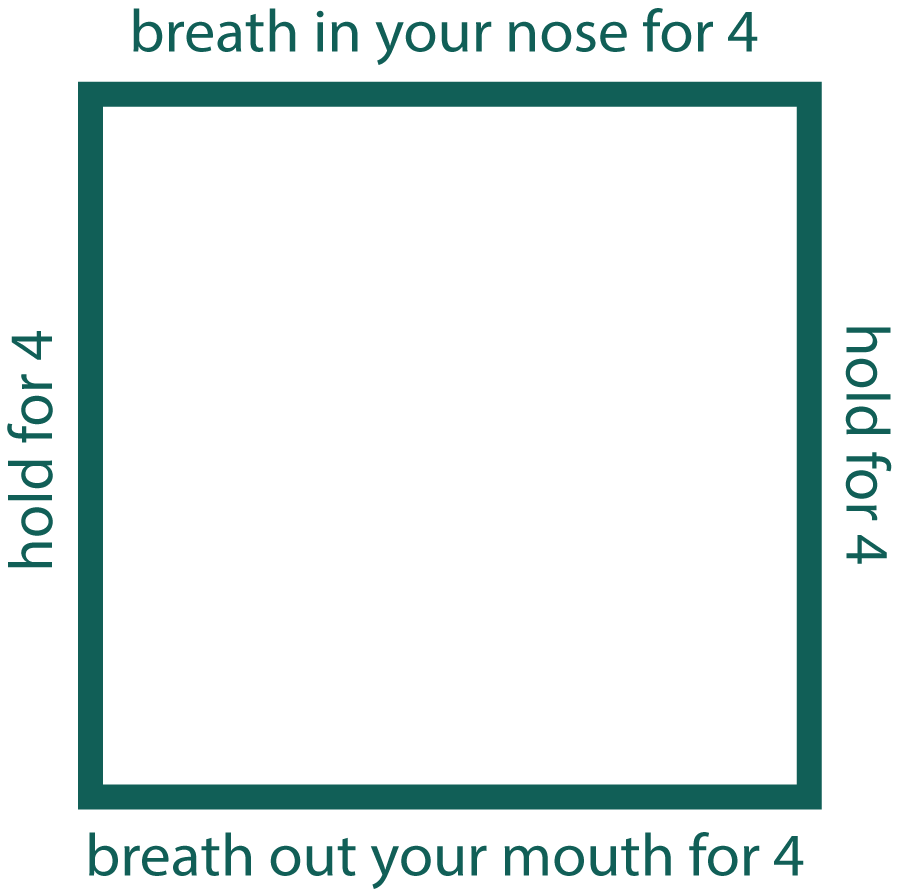
Box breathing is a highly recommended technique that is easy to do anytime, anywhere, to calm the mind and body.
Anxiety is often accompanied by shallow, erratic breath, which can only further increase unpleasant symptoms – more on that later.
Learning a slow, conscious breathing technique, like box-breathing, can help to create a single focus and eliminate the possibility of hyperventilation.
As somebody who suffers from anxiety attacks, box breathing has been a tool that has helped me re-center myself in times of high anxiety.
Here we will learn how to use box breathing (also known as square breathing or four-part breathing), when to implement it, and why breathwork helps with anxiety.
How to Use Box Breathing
Box breathing is a simple technique. It has been used by people in high-stress positions, like US Navy Seals, and by everyday folks, like myself, who need a little extra help when managing stress or anxiety.
The process as four simple parts. To begin, sit down with your feet flat on the floor, preferably sitting with a straight back, and expel all air from your lungs.
- Breathe in your nose for a count of four.
- Hold for a count of four.
- Breathe out of your mouth for a count of four.
- Hold for a count of four.
Complete this rotation for four to eight breath cycles. It is encouraged to pay close attention to your breathing as you practice box breathing.
Using the breath as an anchor and focusing on sensations during the inhale and exhale can help refocus the mind from agitating stimuli and racing thoughts that create a mental loop during stress.
Another anxiety-reducing breathing technique is called the 4-7-8 breath, learn how to do it here.

When to Implement Box Breathing
Many experts suggest practicing the box breathing technique in a quiet, peaceful environment to master the rhythm and basics of the practice.
After you master the basics, you can take box breathing out with you into the world wherever you go. Whenever you feel anxiety, stress, overwhelm, irritability, or any other unpleasant emotion arise, you can reset by using box breathing.
This technique is not to push away any unpleasant emotions but rather to allow yourself to experience and let go of them without being overcome by them.
My personal experience with box breathing has been to implement it when feeling the grips of anxiety around my throat and racing thoughts during triggering experiences.
I often try to find a space away from others, if I can, like a bathroom or a quiet room and begin the practice. If I cannot find a quiet area, I practice with my eyes open around others – believe me, they don’t even notice.
I’ve implemented this technique while angry waiting in traffic, stressed walking into work, anxious trying to order from a menu, or overwhelmed when looking at a to-do list. Anyplace and anytime is applicable.
Why Breathwork Helps with Anxiety
Breathwork has been studied for years, and it’s therapeutic effects have often been suggested as a complementary treatment for anxiety.
Anxiety is a red flag, of sorts, in the body and mind that identifies perceived or real threats and reacts by initiating the fight or flight response. This is entirely natural and only becomes a frustrating issue when the mind perceives threats instead of responding to actual danger.
Once the fight or flight response is started, all sorts of chemicals and bodily changes begin – including erratic, quickened, and shallow breathing. These breathing symptoms occur because the body is trying to get as much oxygen to the muscles as possible to fight off or flee from the threat. (1)
To understand the full list of how anxiety feels and what it does to the body, this is an excellent place to start.
A systematic study, reviewing over 15 articles, found that slow breathwork promotes changes in the central nervous system (CNS), which promotes wellbeing. (2)
This review also found that slowed voluntary breathwork, “increased comfort, relaxation, pleasantness, vigor and alertness, and reduced symptoms of arousal, anxiety, depression, anger, and confusion.” (2)
The breath is often used as an anchor in many meditative and mindful practices to center the body and return to the present. This can also help deepen one’s ability to handle stress-induced experiences.
If you are interested in learning more about cultivating a daily mindfulness practice, this is a great article to check out.
Box Breathing FAQ
Box breathing is a simple technique that is also called square breathing of four-part breathing. It is used to slow the breath to increase concentration and lower anxiety.
Box breathing is a four-part breath. You typically perform this breath for four to eight breath cycles.
Box breathing deepens and slows the breath – helping to remove the nervous system from fight or flight mode which increases focus and lowers anxiety.
The 4-4-4-4 breathing technique is also known as box breathing, square breathing or four part breathing. You inhale through the nose for a count of four. Hold for a count of 4. Exhale through the mouth for a count of four. Hold for a count of 4. Repeat for 4 to 8 breath cycles.




[…] For a more extensive explanation of box breathing, visit this article. […]